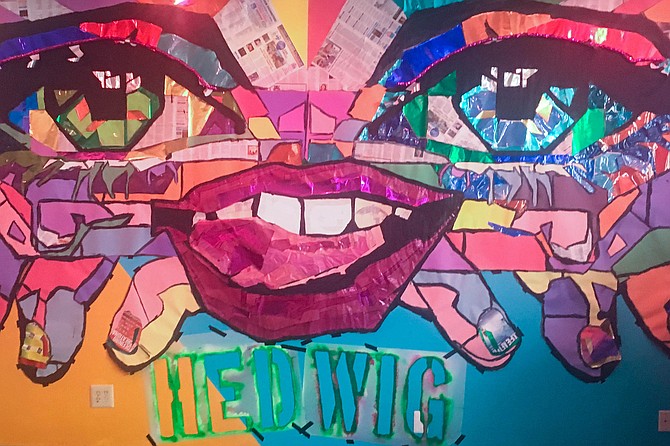 Facebook
Facebook
 X
X
 Instagram
Instagram
 TikTok
TikTok
 Youtube
Youtube

“Ladies and gentlemen, and everyone in between,” says the titular character in the Diversionary Theatre staging of Hedwig and the Angry Inch, which runs through April 28.
It’s been 20 years since the off-Broadway sensation first told the story of Hedwig, née Hansel, the glam rock singing casualty of an incomplete gender reassignment surgery, who is neither completely male nor female. Though it suits the non-binary role seamlessly, the “everyone in between” part wasn’t written into the original 1999 script.
The expression “Ladies and gentlemen, and everyone in between" has emerged more recently as public declaration embracing the inclusion of nontraditional gender identities in mainstream culture.
Gender fluid actor Ruby Rose made transatlantic headlines in 2015 by using the line while hosting the MTV Europe Music Awards broadcast. Prior to that, drag queen Sharon Needles likewise drew internet props for opening a performance with the turn of phrase on a 2012 episode of the cross-dressing reality game show, RuPaul’s Drag Race.
Ironically, the same line turns up online as early as 2010, when an unimpressed fan of the show, Homorazzi.com blogger Tommy D, equanimously wrote, “Ladies and gentlemen, and everyone in between. RuPaul’s Drag Race has officially entered SUCK ASS territory.”
But what is likely the earliest iteration took place in 1977, during a comedy roast of TV actor Ted Knight, broadcast on NBC’s Dean Martin Show. Roughly an hour into the star-studded affair — which sees the likes of Jimmy Walker following Jimmy Stewart in telling jokes at Knight’s expense — ophthalmologist Dr. Renée Richards takes the dais.
Richards isn’t there in any medical capacity. She was born Richard Raskind, a noted doctor and amateur tennis player who had transitioned to female in 1975, at age 40. In 1976, the United States Tennis Association instituted a new policy of chromosomal gender testing to prevent Richards from playing in the U.S. Open as a woman. When she took the Association to court, she became world-famous as the public face of transsexual rights.
During the roast, the usually cool Dean Martin fidgets a bit while introducing her, trying to navigate the appropriate identifying terms. “Our next guest is verrry unusual,” he notes, “one of the most talked about people of today.”
“Thank you, Deanie,” she replies, landing her first joke, “It’s nice to be here with you, and all these ladies and gentlemen, and anyone in between.”
The editor cuts to a cheery Orson Welles, who looks as though he’s never laughed so hard.
Subsquently, Renée Richards would become the modern world’s first transgender professional athlete, when she won her suit to play in the women’s tournament of the 1977 U.S. Open. She lost in the first round to Virginia Wade, who ultimately won the tournament.
But, possibly with the help of a couple of well-placed television comedy writers, she gave life to a phrase that adds an inclusive contemporary twist to a centuries old salutational cliché.


“Ladies and gentlemen, and everyone in between,” says the titular character in the Diversionary Theatre staging of Hedwig and the Angry Inch, which runs through April 28.
It’s been 20 years since the off-Broadway sensation first told the story of Hedwig, née Hansel, the glam rock singing casualty of an incomplete gender reassignment surgery, who is neither completely male nor female. Though it suits the non-binary role seamlessly, the “everyone in between” part wasn’t written into the original 1999 script.
The expression “Ladies and gentlemen, and everyone in between" has emerged more recently as public declaration embracing the inclusion of nontraditional gender identities in mainstream culture.
Gender fluid actor Ruby Rose made transatlantic headlines in 2015 by using the line while hosting the MTV Europe Music Awards broadcast. Prior to that, drag queen Sharon Needles likewise drew internet props for opening a performance with the turn of phrase on a 2012 episode of the cross-dressing reality game show, RuPaul’s Drag Race.
Ironically, the same line turns up online as early as 2010, when an unimpressed fan of the show, Homorazzi.com blogger Tommy D, equanimously wrote, “Ladies and gentlemen, and everyone in between. RuPaul’s Drag Race has officially entered SUCK ASS territory.”
But what is likely the earliest iteration took place in 1977, during a comedy roast of TV actor Ted Knight, broadcast on NBC’s Dean Martin Show. Roughly an hour into the star-studded affair — which sees the likes of Jimmy Walker following Jimmy Stewart in telling jokes at Knight’s expense — ophthalmologist Dr. Renée Richards takes the dais.
Richards isn’t there in any medical capacity. She was born Richard Raskind, a noted doctor and amateur tennis player who had transitioned to female in 1975, at age 40. In 1976, the United States Tennis Association instituted a new policy of chromosomal gender testing to prevent Richards from playing in the U.S. Open as a woman. When she took the Association to court, she became world-famous as the public face of transsexual rights.
During the roast, the usually cool Dean Martin fidgets a bit while introducing her, trying to navigate the appropriate identifying terms. “Our next guest is verrry unusual,” he notes, “one of the most talked about people of today.”
“Thank you, Deanie,” she replies, landing her first joke, “It’s nice to be here with you, and all these ladies and gentlemen, and anyone in between.”
The editor cuts to a cheery Orson Welles, who looks as though he’s never laughed so hard.
Subsquently, Renée Richards would become the modern world’s first transgender professional athlete, when she won her suit to play in the women’s tournament of the 1977 U.S. Open. She lost in the first round to Virginia Wade, who ultimately won the tournament.
But, possibly with the help of a couple of well-placed television comedy writers, she gave life to a phrase that adds an inclusive contemporary twist to a centuries old salutational cliché.
Comments